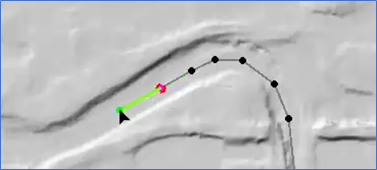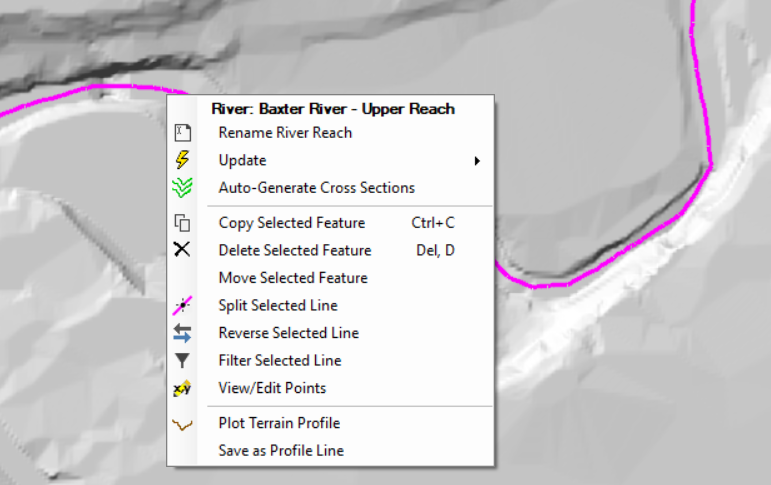Download PDF
Download page Editing Tools.
Editing Tools
The editing capabilities will allow the RAS user to create geospatial 1D and 2D geometry directly in HEC-RAS, based on an underlying Terrain dataset. It is a difficult task to provide editing tools flexible enough to handle the complexities of editing, modifying, and processing all of geospatial data required with a minimalist set of tools. However, every attempt was made to make the editing tools environment as simple and straight forward as possible so that the user can easily find a desired operation. The development of Editing Tools have resulted in two essential tools: the Add New Feature tool and the Select/Edit Feature tool. All operations can be performed by selecting one of the two tools - the user can either add a new feature or right-click on a existing (selected) feature to access editors and perform edits. Access to perform actions on multiple feature are accessible through a right-click on the layer.
The integration of editing tools directly in RAS Mapper should make developing HEC-RAS models more efficient and encourage the development of a more refined hydraulics model. Users will be able to spend more time refining geometry to give accurate model results and spend less time struggling with data development.
To begin editing the Geometry layers, right-click on the Geometry Layer and select Edit Geometry. The Editing Toolbar, shown below, will be added to the Map Display. The standard RAS Mapper toolbar will also be active while during and edit session, so you can switch to the Pan or Zoom tools while editing; however you must click on the  Select Features tool to reactivate the Edit Toolbar.
Select Features tool to reactivate the Edit Toolbar.
![]()
The Edit Toolbar is only available if the  Select Features tool is active on the main RAS Mapper Toolbar.
Select Features tool is active on the main RAS Mapper Toolbar.
| Tool | Description | |
|---|---|---|
Add New |
| Adds a new feature. |
Select/Edit Feature |
| Select features by left-clicking and dragging. Insert a point with a left-click near the line. |
Undo |
| Undo the last edit operation. |
Redo |
| Redo the last edit operation |
Plot Elevations |
| Plot the elevation profile under the selected feature. |
Tools |
| There are many edit operations that will work on the selected set. |
Copy, Paste and Delete Feature options are available. | ||
Reverse Feature will reverse the order of the points in a line feature. | ||
Merge Feature will combine the selected features. For line features, this tool is very robust, but for polygon features, the polygons must overlap. | ||
Clip - Preserve will clip against overlapping polygons, preserving the selected feature. (Polygons must intersect.) | ||
Clip - Discard will clip against overlapping polygons, discarding the overlapping portion of the selected feature. (Polygons must intersect.) | ||
Buffer Polygon will enlarge or shrink the selected feature by the buffer value. | ||
Filter will filter the points on a feature given a user tolerance. The Douglas-Peucker filtering algorithm used throughout RAS is implemented with this tool. | ||
View/Edit Points will bring up a dialog with all of the points in the feature. You can then modify the points in the table. | ||
Help |
| Opens an interactive help dialog to give the user quick tips on the editing options. |
Additional Options | Right-click to re-center the Map View on the cursor. Use the Tab key to switch between Add New and Edit Feature modes. |
There are user-specified options available to help the user visualize what will happen next within the editor. The Selection Color (magenta, bright pink, is default) is used to indicate that a feature is selected and can be moved, copied, deleted, etc. A selected feature can also be “opened for editing” to edit points on the line or polygon. Once a feature open for editing, the symbology will change from the selection color to the Editor Symbology (grey line with black points). The Action Color (chartreuse, bright green, is default) will indicate that an action will occur if the user clicks. For instance, if the mouse hovers over a point, it will change color to the action color indicating that it will be “grabbed” if the user clicks on it and will remain the action color as it is moved. Further, if dealing with a line or polygon feature, action color lines will indicate that what the feature will look like if a point is inserted.
The tolerance for how close the mouse cursor needs to be to a point to select it is specified by the the “Near Point” tolerance. The tolerance for how close the mouse cursor needs to be to insert a point on a line or polygon is specified by the “Near Line” tolerance. These values can be user-specified from the Tools | Options menu.
Add New 
The Add New tool is used to create new features. Use the left mouse button to add a new feature or extend the selected line. As shown in the figure below, the location of the new point (as well as the new segment that will be created for a polyline or polygon feature) will be shown in the Action color defined in the Editor Options (accessed from the Tools | Options menu item).

When finished with adding the new feature, double-click to end the polyline or polygon (point features do not require a double-click) and "close" it from editing. When finishing a feature, often a dialog will be invoked requesting that you name the feature. For instance, when you finish a river line, the River/Reach naming dialog will be displayed, requesting a name. A unique default name will be provided for you, so you will not be required to provide a name.
Select/Edit Feature
The Select/Edit Feature tool is used to create select existing features and then edit the feature. This tool can be used to modify the entire feature (move, delete, etc.) or modify a portion of the feature. The Selected feature will be drawn in the Selection color. The Selection color may be changed in the General Options (accessed from the Tools | Options menu item).
To select a feature, click the feature or click and drag a selection rectangle, as shown below.

To modify a feature, select it, then perform one of the available options : (1) double-click to edit the feature, (2) left-click to drag it, (3) right-click to get a list of options available for the feature. Shown in the figure below, are the right-click options available for the a River Layer polyline feature.

In order to edit a feature, it must be “open for editing”. This is done by double-clicking the feature. Once the selected feature is opened, the feature will be drawn with the Editor Symbology, defined in the Editor Options (accessed from the Tools | Options menu item). (The default edit symbology is grey lines and black points.) Typical editing operations such as inserting, moving and deleting points can then be performed on the open feature through a left click. To perform operations such as deletion on multiple points, perform a selection using click-drag and then press the Delete key. 
To finish editing a feature, double-click off of the feature to close it.




